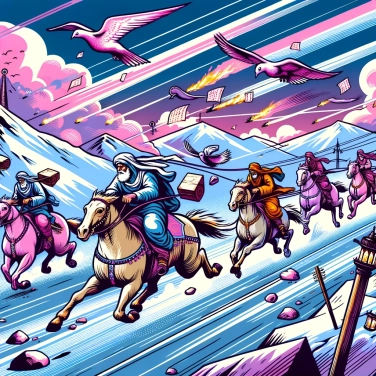The ancient Persians were known for their efficient communication system due to their network of rider relays called the royal postal system, which allowed for messages to be transmitted over long distances in record time.

The Persians had developed a superb road network, notably consisting of the famous Royal Road, approximately 2500 kilometers long. This major road directly connected the ends of the empire, from Susa to Sardis. To be efficient, they took care of the roads: regular maintenance, repair of bridges or difficult passages, and even clearly marked milestones to simplify travel. As a result, messengers could travel quickly, safely, without getting lost along the way. This well-organized road system provided the Persian Empire with exceptional speed and efficiency, which were truly noted by other ancient civilizations.
The ancient Persians had established a sort of messenger network, called royal couriers, who raced from station to station. Each relay, located about every 20 to 30 kilometers, provided fresh messengers with a quick rest and, above all, a rested horse ready to continue. Thanks to these regular stops, messages crossed the empire at an impressive speed; some documents covered in one week what normally took a month of travel. Herodotus himself was impressed by this efficiency, stating that "neither snow, nor rain, nor heat, nor darkness" could slow down these tireless carriers of the Persian royal mail.
The Persians understood early on the importance of carrier pigeons for quickly sending sensitive information. In an era without technology, these birds were perfect: fast, reliable, and capable of covering long distances in a short amount of time. Small rolled messages were attached to their legs, often urgent military notes or important administrative instructions. Their dovecotes were placed at strategic points, allowing the pigeons to easily find their destination and ensuring maximum efficiency in official communications. No need for a secure route or a fast rider when you have a bird that flies straight to the point!
Persian messengers were carefully selected and trained from a young age, with a rather tough program. They primarily learned to ride horses quickly and sustainably, even over difficult or dangerous terrain. They were also taught to identify their route and to memorize complex verbal messages precisely to avoid mistakes. Their training emphasized physical endurance, memory, and adaptability to unexpected situations, so they could always keep their cool in case of a dangerous mission. No wonder they became ultra-reliable and fast throughout the vast Persian empire.
The Persians understood the strategic importance of safe routes for quickly delivering messages. They established regular watch posts along their routes, monitored by patrols to avoid ambushes and robberies. Some roads, particularly the famous Royal Road, were even specifically protected day and night. Garrisons were stationed along the route, allowing messengers to travel without constantly fearing for their safety and thus transmit important orders more efficiently across their vast empire.
The Greek historian Herodotus stated with admiration that the Persian messengers could cover up to 2,700 kilometers in just a week, thanks to their organized relay system.
The ancient Persians were among the first to systematically use carrier pigeons as a means of quickly transmitting important messages between distant regions.
Ancient records show that the Persian communication routes included relay stations every 25 to 30 kilometers, allowing messengers and horses to rest or be easily replaced.
The Persian messengers were rigorously selected and trained: they had to memorize the messages perfectly to ensure their oral transmission without any alteration over long distances.
In addition to messengers and carrier pigeons, the Persians also used visual signals such as strategically placed beacons on hills or mountains. These fires enabled quick communication at night or over long distances to announce important events or to issue a general alert.
The advanced communication system of the Persians greatly influenced subsequent civilizations, such as the Roman Empire, which borrowed the idea of a relay road network (Roman cursus publicus). Even centuries later, the concept of establishing regular relays for rapid communication remained a fundamental principle in military and administrative logistics, directly inspiring methods used well into the Middle Ages and beyond.
Persian messengers were selected based on their physical endurance, ability to ride horses, and reliability. They had to cover long distances quickly under difficult conditions. Their rigorous training included horse riding, navigating through different regions, and learning techniques to ensure the safety of the messages.
The Persians used carrier pigeons due to their natural ability to find their way back home, allowing for quick and discreet communication in emergencies or when human messengers were too distant or unsafe. The pigeons were trained to return to their usual dovecote, where messages attached to their leg could be quickly retrieved.
A safe and well-maintained road network allowed messengers to travel quickly and smoothly. The Persians had established military garrisons and regular checkpoints along major routes to maintain security, perform immediate repairs, and ensure messengers had access to fresh horses, significantly reducing travel times.
Thanks to the messenger relay stations spaced at regular intervals, such as those established by the 'Royal Road' system, messages could travel up to about 250 to 300 kilometers per day. This allowed information to traverse the empire in just a few days, a remarkable efficiency for ancient times.

No one has answered this quiz yet, be the first!' :-)
Question 1/5